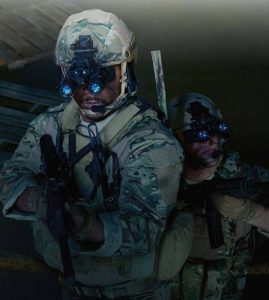Elbit Systems of America has finalized its $350 million acquisition of Harris Corp.’s night vision business, with the company looking for the partnership to enhance offerings for future F-35 helmet-mounted displays (HMD) and opportunities with the Army’s Next-Generation Combat Vehicle and Future Vertical Lift program.

CEO Ranaan Horowitz and Erik Fox, vice president of the night vision business, told reporters Monday the deal will look to expand Elbit America’s defense portfolio by bringing together Harris’ image-intensifying technology together with its HMD and augmented reality capabilities.
“The trend now is to use different sensors together with augmented reality. The capability that Erik and his people and their night vision brings to us is very key for the future and for maintaining our leadership position in both day and night visual acuity,” Horowitz said.
Harris was required to divest of its night vision business, headquartered in Roanoke, Virginia, following its recent merger with L3 Technologies.
“We see the night vision business as a well-run organization. It will continue to do so. And what we’re really focused on is the technology and business solutions synergy and how we combine the capabilities from Roanoke with the capabilities we have in Ft. Worth, [Texas],” Horowitz said.
Fox noted that, before the Elbit America acquisition, L3Harris [LHX] was working on the Army and Marine Corps’ next-generation night vision programs the Enhanced Night Vision Goggle-Binocular (ENVG-B) and Squad Binocular Night Vision Goggle (SBNVG), respectively.
“We’re positioned very well on two of the most relevant contracts in our industry going on right now,” Fox said. “We’re really excited to be on those two platforms, and only see that as Elbit Systems of America we’re well-situated and even more prepared to provide those solutions to the Marine Corps and the Army.”
The Army is set to field its first unit with the ENVG-B this week to soldiers at Fort Riley in Kansas (Defense Daily, Sept. 13). On Sept. 10, the Marine Corps awarded L3Harris a $249 million contract to deliver 14,000 SBNVGs, with plans to begin fielding next spring (Defense Daily, Sept. 10).
Horowitz said Elbit America currently has night vision products that rely on thermal imagery, noting that Harris’ imagine-intensifying technology would be required for future programs such as the next-generation F-35 helmet display.
“One of the first things we’re working together is enhancing some of the night vision performance that’s part of our F-35 Helmet-Mounted Display System,” Horowitz said, adding that such a capability could be deployed with a few years.
Both Horowitz and Fox said they’re placing a high priority on bridging their capabilities to go after potential opportunities with the Army’s signature next-generation platforms.
“With the sensors that are currently being developed by the night vision business for the next generation, combining that with the Helmet-Mounted Display System, we see a potential to bring systems for piloting on helicopters, but also fixed-wing, with much better acuity,” Horowitz said, specifically citing the Future Vertical Lift program.
Horowitz added that Elbit America could explore further acquisition opportunities that would ““augment its portfolio and strengthen with some unique technologies and capabilities.”